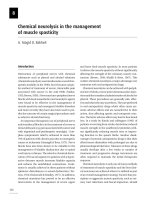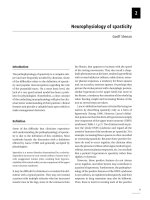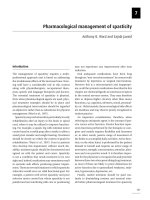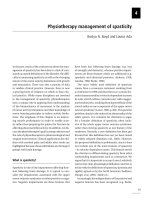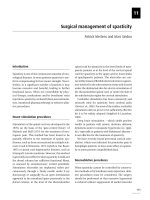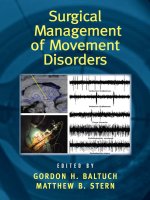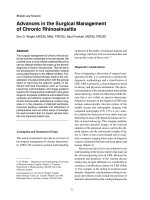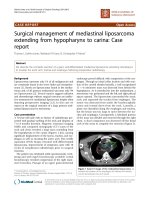Surgical management of spasticity
Bạn đang xem bản rút gọn của tài liệu. Xem và tải ngay bản đầy đủ của tài liệu tại đây (1.42 MB, 21 trang )
11
Surgical management of spasticity
Patrick Mertens and Marc Sindou
Introduction
Spasticity is one of the commonest sequelae of neu-
rological diseases. In most patients spasticity is use-
ful in compensating for lost motor strength. Never-
theless, in a significant number of patients it may
become excessive and harmful, leading to further
functional losses. When not controllable by phys-
ical therapy, medications and/or botulinum toxin
injections, spasticity can benefit from neurostimula-
tion, intrathecal pharmacotherapy or selective abla-
tive procedures.
Neuro-stimulation procedures
Stimulation of the spinal cord was developed in the
1970s on the basis of the ‘gate-control theory’ of
Melzach and Wall (1974) for the treatment of neu-
rogenic pain. This method has been found to be
partially effective in the treatment of spastic syn-
dromes, such as those encountered in multiple scle-
rosis (Cook & Weinstein, 1973; Gybels & Van Roost,
1987) or spinal cord degenerative diseases, such as
Strumpell–Lorrain syndrome. However, this method
is generallymost effective when spasticityis mildand
the dorsal column has sufficient functional fibres,
as assessed by somatosensory evoked potentials.
Stimulation electrodes are implanted, either per-
cutaneously through a Tuohy needle under X-ray
fluoroscopy or surgically via an open interlaminar
approach in the extradural space posteriorly to the
dorsal column, at the level of the thoracolumbar
spinal cord for spasticity in the lower limbs of para-
paretic patients or at the level of the cervical spinal
cord for spasticity in the upper and/or lower limbs
of quadriparetic patients. The electrodes are con-
nectedbymeans offlexibleelectrical wirestoa gener-
ator inserted in the subcutaneous tissue and located
under the abdominal skin for electro-stimulation of
the thoracolumbar spinal cord, or under the skin of
the subclavicular region for cervical stimulation.
Cerebellar stimulation has been extensively and
seriously tried for spasticity from cerebral palsy
(Davis et al., 1982). For most of thestudies, cerebellar
stimulation did not prove to be sufficiently effective
for it to be widely adopted (Seigfried & Lazorthes,
1985).
Deep brain stimulation – which yields positive
results in patients with tremor, dystonia, akinesia,
dyskinesia and/or nonspastic hypertonia (i.e. rigid-
ity), especially in patients with Parkinson’s disease –
is not effective for the treatment of spasticity.
We have recently found precentral cortical stim-
ulation, which was indicated for poststroke pain in
hemiplegic patients, to have some effect on spastic-
ity in some patients (unpublished data).
Neuroablative procedures
When spasticity cannot be controlled by conserva-
tive methods or by botulinum toxin injections, abla-
tive procedures must be considered. The surgery
should be performed so that excessive hypertonia
is reduced without suppression of useful muscular
193
194 Patrick Mertens and Marc Sindou
tone or impairment of the residual motor and sen-
sory functions. Therefore, neuroablative techniques
must be as selective as possible. Such selective
lesions can be performed at the level of peripheral
nerves, spinal roots, spinal cord or the dorsal root
entry zone.
Peripheral neurotomies (PNs)
Selective PNs were introduced first for the treatment
of spastic deformities of the foot by Stoffel (1913).
Later, Gros et al. (1977) and Sindou and Mertens
(1988) advocated making neurotomies more selec-
tive by using microsurgical techniques and intra-
operative electrical stimulation for better identifica-
tion of the function of the fascicles constituting the
nerve. Selectivity is required to suppress the excess
of spasticity without producing excessive weakening
of motor strengthand severe amyotrophy. To achieve
this goal, preserving at least one-fourth of the motor
fibres is necessary.
Neurotomies are indicated when spasticity is
localized to muscles or muscular groups supplied
by a single or a few peripheral nerves that are easily
accessible. To help the surgeon decide if neurotomy
is appropriate, temporary local anaesthetic block of
the nerve (with lidocaine or with long-lasting bupi-
vacaine) can be useful. Such a test can determine if
articular limitations result from spasticity or muscu-
lotendinous contractures and/or articular ankyloses
(only spasticity is decreased by the test). In addition,
these tests give the patient an idea of what to expect
from the operation. Botulinum toxin injections may
also act as a ‘prolonged’ test for several weeks or
months.
Lower limbs
For spasticity in the lower limbs (Mertens & Sin-
dou, 1991), neurotomies of the tibial nerve at the
popliteal region (Fig. 11.1) and of the obturator nerve
just below the subpubic canal (Fig. 11.2) are the most
common for the so-called spastic foot and for spastic
flexion-adduction deformity of the hip, respectively.
Tibial neurotomy is performed as follows. After
exposure of the tibial nerve from the popliteal region
down to the soleus muscular arcade under general
anaesthesia not using curare, all the branches are
individualized and identified one by one, using the
operating microscope and bipolar stimulation. Each
branch (or fascicle) considered as supporting harm-
ful spasticity on the basis of stimulation is then par-
tially resected over a 5-mm length to prevent regen-
eration. Conservation of one-third to one-fifth of
the fibres of each branch is sufficient to avoid loss
of motor function and amyotrophy. Comparing the
results of stimulation of the distal and proximal parts
of the resected fibres proved useful in controlling
the effects of the operation on muscular contraction.
The particular branches of the nerve to be operated
on are determined preoperatively by analyzing all
the components of the spastic disorder, according
to the following schedule: (1) equinus and/or ankle
clonus requires sectioning of the soleus nerve(s) and,
if necessary, the two gastrocnemius branches; (2)
varus necessitates interruption of the posterior tib-
ial nerve; and (3) tonic flexion of the toes requires
sectioning of the flexor fascicles situated inside the
distal trunk of the tibial nerve. Their precise identi-
fication, avoiding sensory fascicles, is of paramount
importance in avoiding hypoaesthesia and dysaes-
thetic disturbances as well as trophic lesions of the
plantar skin.
In 180 patients, 82% of tibial PNs resulted in sup-
pression of the disabling spasticity with improve-
ment of the residual voluntary movements (P.
Mertens & M. Sindou, unpublished data). We have
recently published the results of a multicentre study
of the long-term results of tibial neurotomy (Buf-
fenoir et al., 2004). This multicentre, prospective
study was conducted between 1999 and 2003 and
55 patients with spastic equinus foot were treated
in five neurosurgical centres. No postoperative com-
plications were observed in this series. Gait analy-
sis demonstrated a statistically significant increase
in the speed of gait after the surgical treatment and
improvements in the equinus score and foot appear-
ance. Overall 92.7% of preoperative objectives had
been achieved in the series, and there seemed to be
Figure 11.1. Selective tibial neurotomy. Left: Skin incision in the right popliteal fossa. Centre: Dorsal view showing tibial
(1), and peroneal (2) nerves, sural (sensory) nerve (3), medial gastrocnemius and lateral gastrocnemius branches (4), soleus
nerve (5), posterior tibialis nerve (6). The distal trunk of the tibial nerve, just above the soleus arch (S), contains 15 to 18
fascicles averaging 1 mm in diameter each; two thirds are sensory. Equinus and ankle clonus require section of the soleus
nerve (5) and, if necessary, of the medial and lateral gastrocnemius nerve (4). Varus necessitates interruption of the
posterior tibialis nerve (6). Tonic flexion of the toes requires section of the flexor fascicles situated inside the distal trunk of
the tibial nerve (7); their precise identification apart from the sensory fascicles by electrical stimulation is of paramount
importance to avoid hypoaesthetic and dysaesthetic disturbances, as well as trophic lesions of the plantar skin. Upper
right: Operative view of the resection, over 7 mm in length (between the two arrows), of two-thirds of the soleus nerve (SN).
Lower right: Operative view of five dissected fascicles inside the distal part of the tibial nerve (TN) at the level of the soleus
arch, after the epineural envelope has been opened.
Figure 11.2. Obturator neurotomy. Skin incision on the relief of the adductor longus muscle. Dissection of the anterior
branch (AB) of right obturator nerve (ON). The adductor longus muscle (AL) is retracted laterally and gracilis muscle (G)
medially. The nerve is anterior to the adductor brevis muscle (AB). The adductor brevis nerve (1 and 2), adductor longus
nerve (3) and gracilis nerve (4 and 5) are shown. The posterior branch (PB) of the obturator nerve lies under the adductor
brevis muscle (AB).
196 Patrick Mertens and Marc Sindou
Figure 11.3. Hamstring neurotomy. Skin incision between the ischial tuberosity (IT) and the greater trochanter (GT).
Dissection of the right sciatic nerve (SN), under the piriformis muscle (P), after passing through the fibres of the gluteus
maximus muscle (GM). The epineurium of the nerve is opened and fascicles for hamstring muscles (HF) are located in the
medial part of the nerve. IGN: inferior gluteal nerve; IGA: inferior gluteal nerve artery.
a lasting response at least over the mean follow-up
period of 10 months.
In contrast to the adult, in the spastic hemiplegic
child the effects of tibial PN may be only transient.
In our series of 13 paediatric cases, 8 cases had a
recurrence (Berard et al., 1998).
Selective neurotomy of the branches to the knee
flexors (hamstrings) can also be performed at the
level of the sciatic trunk through a short skin inci-
sion in the buttock (Fig. 11.3). For spastic hyperex-
tension of the first toe (so-called permanent Babin-
ski sign), a selective neurotomy of the branch(es) of
the deep fibular nerve to the hallux extensor can be
useful.
Upper limbs
Neurotomies are also indicated for spasticity in the
upper limbs (Mertens & Sindou, 1991). Selective
fascicular neurotomies can be performed in the
musculocutaneous nerve for spastic elbow flexion
(Fig. 11.4), and in the median (and ulnar) nerve
for spastic hyperflexion of the wrist and fingers
(Fig. 11.5).
The last procedure, which consists of sectioning
the branches to the forearm pronators, wrist flexors
and extrinsic finger flexors, is indicated for spasticity
in the wrist and the hand – the aim being to open
the hand and improve prehension. As the fascicular
organization of the median and ulnar nerves does
not allow for differentiation of motor from sensory
fascicles at the level of their trunks, it is necessary
to dissect the motor branches after they have left
the nerve trunk in the forearm. Special care must
be taken with the sensory fascicles to avoid painful
manifestations.
Neurotomies of brachial plexus branches have
now been developed for treating the spastic shoul-
der (Decq et al., 1997). The pectoralis major mus-
cle and teres major muscle are the main muscles
implicated in this condition. This excess of spas-
ticity restrains the active (and passive) abduction
Surgical management of spasticity 197
Figure 11.4. Musculocutaneous neurotomy brachialis. Skin incision along the medial aspect of the biceps brachii.
Dissection of the right musculocutaneous nerve (MC) in the space between the biceps brachii (BB) laterally, the
coracobrachialis (CB) medially, and the brachialis (B) posteriorly. Branches to brachialis (1 and 2) and to biceps brachii
(3 and 4). The humeral artery (H) and the median nerve are situated medially (they are not dissected).
and external rotation of the shoulder. The pectoralis
major nerve can be easily reached via an anterior
approach of the shoulder. With the patient supine
and the upper limb lying alongside the body, an
incision is made at the innermost part of the delto-
pectoral sulcus and curves along the clavicular axis.
The teres major nerve can be approached posteriorly
to the shoulder. With the patient in procubitus posi-
tion and the upper limb lying alongside the body, a
vertical incision is made along the inner border of
the teres major. Decq et al. (1997) found a signifi-
cant increase in amplitude and speed in the active
mobilization of the spastic shoulder, leading to bet-
ter functional use in five patients after surgery. Selec-
tive peripheral neurotomy for the treatment of spas-
tic upper limb does seem to lead to long-term satis-
factory improvement in functional and/or comfort
with a low morbidity rate in appropriately selected
patients,as recentlyconfirmedin aprospective study
in 31 patients published by Maarrawi and colleagues
(Maarrawi et al., 2006).
Improvement of motor function
Basically, selective neurotomies are able not only to
reduce excess of spasticity and deformity but also
to improve motor function by re-equilibrating the
tonic balance between agonist and antagonist mus-
cles (Fig. 11.6). This was certainly true for 82% of 180
adult patients operated on for spastic foot using tib-
ial PN. In our experience – since 1980 and more than
300 operations – tibial neurotomy has been the most
frequently used PN (Mertens & Sindou, unpublished
data).
With regard to the spastic hand, which is a very
difficult problem to deal with, a functional bene-
fit in prehension can only be achieved if patients
retain a residual motor function in the extensor and
198 Patrick Mertens and Marc Sindou
Figure 11.5. Median neurotomy (slightly modified from
Brunelli’s technique). Top: Skin incision on the right
forearm from the medial aspect of the biceps brachii at the
level of the elbow to the midline above the wrist. Centre:
First stage of the dissection; the pronator teres (PT) is
retracted upward and laterally, and the flexor carpi radialis
(FCR) is retracted medially. Branches from the median
nerve (MN), before it passes under the fibrous arch of the
flexor digitorum superficialis (FDS), are dissected. These
branches are (1) to the pronotor teres and (2,3) two nerve
trunks to the flexor carpi radialis, palmaris longus and
flexor digitorum superficialis. Bottom: Second stage of the
dissection; the fibrous arch of the FDS is sectioned to allow
more distal dissection of the median nerve. The FDS is
retracted medially, and branches from the median nerve
are identified to the (1) flexor pollicis longus (FPL),
supinator muscles together with a sufficient residual
sensory function. If these conditions are not present,
only better comfort and better cosmetic aspect can
be achieved.
We recently performed 25 median (and ulnar)
neurotomies combined with tenotomies (predom-
inantly of the epicondyle muscles) in the forearm
(namely a Page–Scaglietti operation) (Brunelli &
Brunelli, 1983) to treat spastic flexion of the wrist
and fingers with tendinous contractures. All patients
in this special group – who did not have any volun-
tary effective motor function preoperatively – had a
better comfort and good cosmetic effect, but without
any significant functional benefit.
Posterior rhizotomies
Posterior rhizotomy was performed by Foerster for
the first time in 1908 to modify spasticity (Foer-
ster, 1913), after Sherrington had demonstrated
in 1898 using an animal model that decerebrate
rigidity could be abolished by sectioning the dor-
sal roots, that is, by interruption of the afferent
input to the monosynaptic stretch and polysynap-
tic withdrawal reflexes. Its undesired effects on
sensory and sphincter functions limited its appli-
cation in the past. To diminish these disadvan-
tages, several surgeons in the 1960s and 1970s
attempted to develop more selective operations,
especially for the treatment of children with cerebral
palsy.
Posterior selective rhizotomy
To reduce the sensory side effects of the origi-
nal Foerster method, Gros et al. (1967) introduced
a technical modification that consisted of sparing
one rootlet in five of each root, from L1 to S1.
Using similar principles, Ouaknine (1980), a pupil
of Gros, developed a microsurgical technique that
(2) flexor digitorum profundus (FDP) and (3) the
interosseous nerve and its proper branches to these
muscles.
Surgical management of spasticity 199
(a)
(b)
Figure 11.6 Movement analysis in a hemiplegic patient with a spastic foot (equinovarus) before and after selective tibial
neurotomy. (a) Surface polyelectromyography of the tibialis anterior (LAED) and the triceps surae (LPD) muscles on the
spastic leg during walking. Left: Preoperative recordings showing desynchronized activities of the triceps surae, with
abnormal co-contractions of antagonist muscles – triceps surae and tibialis anterior. Right: After selective tibial neurotomy
there is a reappearance of muscular activities in the tibialis anterior muscle, a clear decrease in triceps surae activities and
normal alternance of contractions of these muscles (i.e. triceps surae at the end of the stance phase and tibialis anterior
during the swing phase). (b) Tridimensional movement analysis of the ankle flexion-extension amplitude during the gait
with VICON system. Left: Preoperatively, the amplitude of the spastic ankle is limited to 18 degrees of dorsal flexion. Right:
After selective tibial neurotomy, the dorsal flexion increased to 32 degrees. Thus, the tonic balance of the ankle has been
re-equilibrated by the selective tibial neurotomy; consequently, motor function and gait have been improved.
consisted of resectioning one third to two thirds of
each group of rootlets of all the posterior roots from
L1 to S1.
Sectorial posterior rhizotomy
In an attempt to reduce the side effects of rhi-
zotomy on postural tone in ambulatory patients,
Gros (1979) and his pupils Privat et al. (1976) and
Frerebeau (1991) proposed a topographic selec-
tion of the rootlets to be sectioned. Firstly, a pre-
operative assessment is done to differentiate the
‘useful spasticity’ (i.e. the one sustaining postu-
ral tone – abdominal muscles, quadriceps, gluteus
medius) from the ‘harmful spasticity’ (i.e. the one
responsible for vicious posture – hip flexors, adduc-
tors, hamstrings, triceps surae). This is followed by
mapping the evoked motor activity of the exposed
rootlets,from L1 to S2, bydirect electrostimulationof
each posterior group of rootlets. Finally, the rootlets
to be sectioned are determined according to this pre-
operative programme.
200 Patrick Mertens and Marc Sindou
Partial posterior rhizotomy
Fraioli and Guidetti (1977) reported on a procedure
for dividing the dorsal half of each rootlet of the
selected posterior roots a few millimetres before its
entrance into the posterolateral sulcus. Good results
were obtained, without significant sensory deficit.
This can be explained by the fact that partial sec-
tioning leaves intact a large number of fibres of all
types.
Functional posterior rhizotomy
The neurological search for specially organized cir-
cuits responsible for spasticity led Fasano et al.
(1976) to propose the so-called functional posterior
rhizotomy. This method is based on bipolar intra-
operative stimulation of the posterior rootlets and
analysis of the types of muscle responses by elec-
tromyography (EMG). Responses characterized by
a permanent tonic contraction, an after-discharge
pattern or a large spatial diffusion to distant mus-
cle groups were considered to belong to disinhib-
ited spinal circuits responsible for spasticity. This
procedure, which was especially conceived for use
with children with cerebral palsy, has been also used
by other outstanding surgical teams, each one hav-
ing brought its own technical modifications to the
method (Peacock & Arens, 1982; Cahan et al., 1987;
Storrs, 1987; Abbott et al., 1989).
Personal technique
Our personal adaptations of these methods are sum-
marized below. Selection of candidates for surgery
was done in a multidisciplinary way, with the reha-
bilitation team, the physiotherapist, the orthopaedic
surgeon and the neurosurgeon being present, as
well as of course the patient’s family. Candidates
were retained only if spasticity was responsible for
a halt in motor skill acquisitions and/or evolutive
orthopaedic deformities in spite of intensive phys-
iotherapy. The main goals of the surgery were clearly
defined for every patient: improvement in comfort;
decrease in orthopaedic risks; improvement for sit-
ting, standing and/or walking; and improvement
in urinary function. The muscles in which there
was a harmful excess of tone and their – anatom-
ically – corresponding lumbosacral roots (i.e. those
to be resected, as well as the degree of their resec-
tioning according to amount of spasticity to be
reduced) were determined by the multidisciplinary
team. The surgical procedure used is detailed in Fig-
ure 11.7. Until recently, we have operated only on
very severely affected children – quadriplegic and
not able to locomote on their own. The results are
reported in Hodgkinson et al. (1996) and summa-
rized in Table 11.1. Since 1995 we have extended
the indications to diplegic children able to walk; the
effects are good, but follow-up in this group is not yet
sufficient to report on the results in detail.
The results of posterior rhizotomies
The results obtained in children with cerebral palsy,
whatever the technical modality of surgery may be,
have been extensively reported in the literature. A
number of publications have confirmed the effi-
cacy of the various dorsal rhizotomy techniques. In
2002, for example, McLaughlin et al. conducted a
Table 11.1. Results according to whether or not
principal goal is reached
Principal goal
Number of
cases
Goal
reached
Goal not
reached
Improvement
in comfort
211
Orthopaedic
risks
624
Improvement
of sitting
position
11–
Improvement
of standing
and walking
862
Improvement
of vesical
function
101
Total 18 10 8

